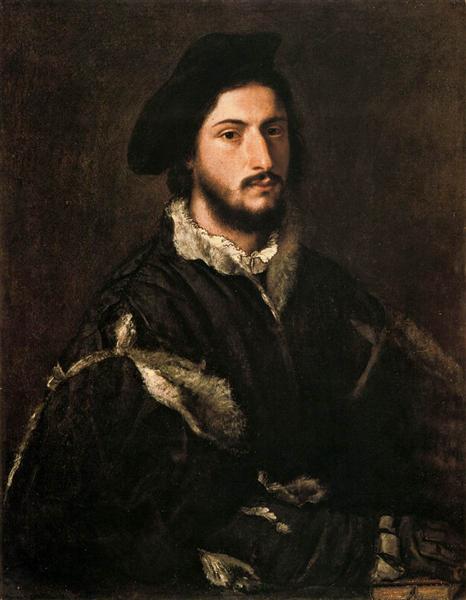Descrizione
Titian's "Portrait of Vincenzo Mosti", painted in 1520, is a work that offers a powerful representation of the technical skill and mastery in capturing human psychology that characterize the work of this Venetian artist. Titian, one of the most important figures of the Renaissance, has managed in this portrait to breathe life into the figure of the donor, Vincenzo Mosti, an Italian nobleman whose bearing and clothing speak of his status in the society of the time.
The work is composed with a meticulous attention to detail that is a hallmark of Titian's work. The figure of Mosti occupies the central plane, presented at a three-quarter angle that not only allows his physiognomy to be appreciated, but also establishes a closer relationship with the viewer. His facial expression is resolute and dignified, with a slight rictus that suggests both introspection and confidence. This use of emotional portraiture has its roots in a tradition of Venetian portraiture, where the representation of the individual becomes a synthesis of his character and status.
Color is one of the most fascinating elements of this work. Titian is known for his bold and expressive use of color, and in this portrait, he combines terracotta hues on the face, with subtle shadows that lend depth and realism to Mosti’s skin. Added to this are the rich blues and greens of his clothing, symbolizing both his social position and the artist’s skill in balancing the palette without losing focus on the subject. The neutral, dark background serves to highlight his figure and avoid any distractions, allowing the viewer’s attention to focus on the complexity of Mosti’s face and posture.
The clothing worn by Vincenzo Mosti is remarkable: a velvet coat over a white shirt, accompanied by a collar that indicates his dignity and position. This aspect of the clothing not only highlights his wealth, but also symbolizes the pride of an era in which portraiture served as a means of social affirmation. Through this type of representation, Titian participates in a broader dialogue about identity and the perception of nobility in the Renaissance.
The work falls within the rich tradition of Venetian portraiture that flourished during this period. Painters such as Giovanni Bellini and Lotto had laid the groundwork for a style that balanced realistic depiction with a strong psychological charge. Titian, however, takes this trend a step further, fusing expert painterly technique with a deep sensitivity to the humanity of his subjects, something that is viscerally felt in the "Portrait of Vincenzo Mosti."
Furthermore, it is important to consider the historical context in which the portrait was created. In 16th-century Venice, portraits were a way of displaying status and power – not simply strokes on the canvas, but statements of social and political existence. Mosti’s portrait is no exception; its creation in 1520 corresponds to a time of reflection on the individual in society, where every feature, every fold of fabric, contributed to telling the story of the person depicted and the times in which they lived.
In conclusion, the “Portrait of Vincenzo Mosti” is a testament to Titian’s skill and vision as a portraitist. The work displays not only the technical prowess that allowed him to capture the essence of an individual in all its complexity, but also the way in which art can operate as a mirror of society. With every detail meticulously executed, this portrait succeeds in breaking down time, inviting viewers to look back and reflect on the nature of power, identity, and the legacy that lives on through art.
KUADROS ©, a famous painting on your wall.
Hand-made oil painting reproductions, with the quality of professional artists and the distinctive seal of KUADROS ©.
Painting reproduction service with satisfaction guarantee. If you are not completely satisfied with the replica of your painting, we will refund 100% of your money.

